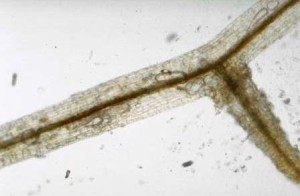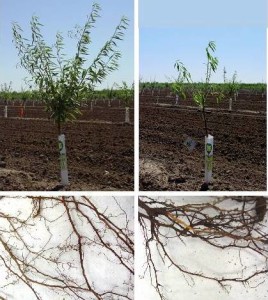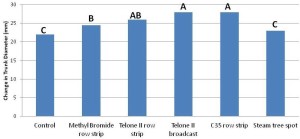BACKGROUND
Collaborative trials. More than 10 almond replant trials were established under sponsorship of the USDA-ARS Pacific Area-Wide Program for Integrated Methyl Bromide Alternatives (PAW-MBA). The trials were made possible through collaboration and in-kind support from USDA-ARS, UC, UCCE, the Almond Board of California (ABC), TriCal Inc., Cal DPR, growers and many others. For almonds, initial focus of the PAW-MBA was on fumigant alternatives to MB, which are highlighted in this summary. More recently, with ABC support, the PAW-MBA program has focused on non-fumigant alternatives, which will be featured (along with fumigant alternatives) in an upcoming issue of the journal California Agriculture (Browne et al.).
Almond replant problems. Growth and yields of replanted almond orchards can be compromised by a myriad of biological and abiotic problems resulting from previous cultivation. Abiotic replant problems can include soil compaction, suboptimal pH, poor fertility, etc., which often can be remediated by prudent soil tillage, soil amendment, etc. Biological replant problems are not fully understood and often are more difficult to control than the abiotic replant problems. Key biological replant problems include nematode parasitism, replant disease, and known aggressive pathogens.

Nematode Parasitism. In California, lesion, ring, and rootknot nematodes can be a concern in replanted almond orchards (Fig. 1). Resistance to rootknot nematode has been incorporated into many almond and peach rootstocks, but there is no genetic resistance identified to date for ring or lesion nematode. At present, these soil-borne pests are best controlled by pre-plant soil fumigation with 1,3-dichloropropene containing fumigants (i.e. Telone-II), and with post plant applications of spirotetramat (Movento).
Replant Disease of Prunus sp. This soilborne disease complex is widespread in successive plantings of almond and peach on sandy and loamy soils. It is apparently caused, at least in part, by a poorly defined complex of soilborne fungi and oomycetes. It is manifested by feeder root damage damage, small root systems, stunted tree growth, and sometimes even tree death (Fig. 2), and yield reductions. Chloropicrin-containing fumigants can prevent PRD.

Aggressive pathogens. Armillaria and Phytophthora are soil-borne pathogens that infect and kill root systems of fruit and nut trees, causing eventual tree death. Fumigants provide only temporary protection from these pathogens.
RESULTS SUMMARY, ALMOND REPLANT TRIALS
Almond plots replanted after pre-plant soil fumigation with chloropicrin- and/or Telone-II containing fumigants have outperformed non-treated control plots and spot steamed (at tree sites) plots in multiple replant trials with growers in the San Joaquin Valley.
Key results of almond replant trials impacted by replant disease but not by plant parasitic nematodes are highlighted in Table 1. In these trials:
- Pre-plant soil fumigation with Telone C35 in row-strips produced 25, 47, and 94% greater kernel yield (lb/acre) than the control in the 7, 6, and 5 year old research plots, respectively.
- Pre-plant fumigation with Telone-II row-strip was not as effective as the C35 row strip– yields increased 12, 20, and 54% in comparison to the control in the 7, 6, and 5 year old research plots, respectively.
- Broadcast applications of Telone-II yielded similarly to C35 row-strip applications in the 7 year old trial.
- The increases in yield were a reflection of increased nutrient and water use efficiency
Key results of almond replant trials impacted by parasitic nematodes (and replant disease) include:
- Trees within fumigated plots have been larger (Fig. 3) and generally had lower counts of plant parasitic nematodes than the control and steamed plots.

Figure 3: The effect of pre-plant treatments on the first year of trunk growth of replanted almonds at the 3 year old trial. Treatments followed by different letters are statistically different (p<0.05). - Full-coverage (i.e., “broadcast) treatment Telone II row-strip treatment with Telone C35 may offer more benefit than row-strip treatment with Telone II (Fig. 3).
- Yield assessments are upcoming, as trees age.
Additional results and discussion:
- Trials indicate that GPS-controlled pre-plant spot application of fumigant to tree planting sites provides adequate control of replant disease and is being optimized in collaboration with TriCal, Inc.
- There has been variation in response to fumigation in almond replant trials. Our results indicate that: pre-plant soil fumigation under suboptimal soil moisture or temperature; suboptimal management of replanted trees; and poorly understood site factors may all lessen the benefit or need for soil fumigation treatments.
- Trials indicate that, at some sites, prudent rootstock selection can help to manage almond replant problems.
- At many sites, pre-plant soil fumigation provides an essential “tool” for managing biological replant problems of almond. Sustained interdisciplinary research will be needed to reduce dependence on soil fumigation while maintaining competiveness.
Table 1: The effect of pre-plant fumigant treatments on cumulative yields of almond orchards replanted in soils impacted by replant disease but not by plant parasitic nematodes. Treatments followed by different letters are statistically different (p<0.05).
|
Fumigant and Rate |
Trt. |
Fum. lbs/Acre |
Cumulative Yield (lbs/acre) |
||
| 4 Year Old | 5 Year Old | 7 Year old | |||
|
Control |
None |
0 |
973 B |
2863 C |
9362 C |
|
Methyl br. (400 lb/acre) |
Row strip (38%) |
180 |
1678 A |
2911 C |
– |
|
TeloneII (340 lb/acre) |
Row strip (38%) |
129.2 |
1496 A |
3449 B |
10501 B |
|
TeloneII (340 lb/acre) |
Broadcast (100%) |
340 |
– |
– |
11849 A |
|
Chloropicrin (200 lb/acre) |
Row strip (38%) |
76 |
1493 A |
3950 A |
– |
|
Chloropicrin (400 lb/acre) |
Row strip (38%) |
152 |
– |
– |
11590 A |
|
Telone C35 (550 lb/acre) |
Row strip (38%) |
209 |
1883 A |
4207 A |
11716 A |

